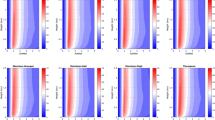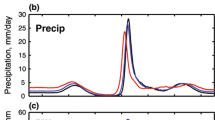Abstract
A two-dimensional version of a hydrostatic mesoscale model with a partial cloudiness scheme is used to study a cold air outbreak event during MASEX (Mesoscale Air-Sea Exchange experiment). The model produces a weak mesoscale circulation which is slightly advected offshore and simulates well an observed cloudiness transition zone of 80 km where the cloud cover ranges between 0 and 100%. It is shown that the cloud top entrainment instability criterion can explain the observed cloudiness phenomenon i.e., the transition from a cumulus field to a solid stratocumulus cloud layer.
The usefulness of the partial cloudiness scheme is demonstrated by comparing the results to those obtained with a simple “all or nothing” condensation scheme. A model sensitivity study shows that the sea surface temperature and the horizontal advection speed control the surface heat and moisture fluxes and so explain the structure and horizontal extent of the cloudiness transition zone.
Similar content being viewed by others
References
Agee, E. M.: 1984, ‘Observations from Space and Thermal Convection: A Historical Perspective’, Bull. Amer. Meteorol. Soc. 65, 938–949.
Agee, E. M., Chen, T. S., and Dowell, K. E.: 1973, ‘A Review of Mesoscale/Cellular Convection’, Bull. Amer. Meteorol. Soc. 54, 1004–1012.
Agee, E. M. and Lomax, F. E.: 1979, ‘Structure of the Mixed Layer Associated with Patterns of Mesoscale Cellular Convection during AMTEX 75’, J. Atmos. Sci. 35, 2281–2301.
Atlas, D., Chou, S.-H., and Byerly, W. P.: 1983, ‘The Influence of Coastal Shape on Winter Mesoscale Air-Sea Interaction’, Mon. Wea. Rev. 111, 245–252.
Bane, J. M. and Osgood, K. E.: 1989, ‘Wintertime Air-Sea Interaction Processes Across the Gulf Stream’, J. Geophy. Res. 94, 755–772.
Bechtold, P., Pinty, J.-P., and Mascart, P.: 1991, ‘A Numerical Investigation of the Influence of Large Scale Winds on Sea-Breeze and Inland-Breeze Type Circulations’, J. Appl. Meteorol. 30, 1268–1279.
Bechtold, P., Fravalo, C., and Pinty, J.-P.: 1992, ‘A Model of Marine Boundary Layer Cloudiness for Mesoscale Applications’, J. Atmos. Sci. (in press).
Boers, R. and Melfi, S. H.: 1987, ‘Cold Air Outbreak during MASEX: Lidar Observations and Boundary-Layer Model Test’, Boundary-Layer Meteorol. 39, 41–51.
Boers, R., Melfi, S. H., and Palm, S. P.: 1991, ‘Cold-Air Outbreak during GALE: Lidar Observations and Modeling of Boundary Layer Dynamics’, Mon. Wea. Rev. 119, 1132–1150.
Bougeault, P.: 1981, ‘Modeling the Trade-Wind Cumulus Boundary Layer. Part I: Testing the Ensemble Cloud Relations Against Numerical Data’, J. Atmos. Sci. 38, 2414–2428.
Bougeault, P. and André, J.-C.: 1986, ‘On the Stability of the Third-Order Turbulence Closure for the Modeling of the Sratocumulus-Topped Boundary Layer’, J. Atmos. Sci. 15, 832–848.
Hsu, W.-R. and Sun, W.-Y.: 1991, ‘Numerical Study of Mesoscale Cellular Convection’, Boundary-Layer Meteorol. 57, 167–186.
Huang, C.-Y. and Raman, S.: 1988, ‘A Numerical Modeling Study of the Marine Boundary Layer over the Gulf Stream during Cold Air Advection’, Boundary-Layer Meteorol. 45, 251–290.
Kao, J. C.-Y. and Yamada, T.: 1989, ‘Numerical Simulations of a Stratocumulus-Capped Boundary Layer Observed Over Land’, J. Atmos. Sci. 15, 832–848.
Klemp, J. B. and Wilhelmson, R. B.: 1978, ‘The Simulation of Three-Dimensional Convective Storm Dynamics’, Ibid J. Atmos. Sci. 35, 1070–1096.
Kuo, H.-C. and Schubert, W. H.: 1988, ‘Stability of Cloud-Topped Boundary Layers’, Q. J. R. Meteorol. Soc. 114, 887–916.
Louis, J.-F.: 1979, ‘A Parametric Model of Vertical Eddy Fluxes in the Atmosphere’, Boundary Layer Meteorol. 17, 187–202.
Mellor, G. L.: 1977, ‘The Gaussian Cloud Model Relations’, J. Atmos. Sci. 34, 356–358.
Morcrette, J.-J.: 1989, ‘Impact of Changes to the Radiation Transfer Parameterizations Plus Cloud Optical Properties in the ECMWF Model’, Mon. Wea. Rev. 118, 847–873.
Nickerson, E. C., Richard, E., Rosset, R., and Smith, D. R.: 1986, ‘The Numerical Simulation of Clouds, Rain, and Airflow Over the Vosges and Black Forest Mountains: A Meso-, Model with Parameterized Microphysics’, Mon. Wea. Rev. 114, 398–414.
Ninomiya, K. and Akiyama, T.: 1976, ‘Structure and Heat Energy Budget of Mixed Layer Capped by Inversion during the Period of Polar Outbreak Over Kuroshio Region’, J. Meteorol. Soc. Japan 54, 160–174.
Randall, D. A.: 1980, ‘Conditional Instability of the First Kind Upside-Down’, J. Atmos. Sci. 37, 125–130.
Sheu, P. J. and Agee, E. M.: 1977, ‘Kinematic Analysis and Air-Sea Heat Flux Associated with Mesoscale Cellular Convection during AMTEX’, J. Atmos. Sci. 34, 793–801.
Sun, W.-Y. and Hsu, W.-R.: 1988, ‘Numerical Study of a Cold Air Outbreak Over the Ocean’, J. Atmos. Sci. 45, 1205–1224.
Sundqvist, H., Berge, E., and Kristjansson, J. E.: 1989, ‘Condensation and Cloud Parameterization Studies with a Mesoscale Numerical Weather Prediction Mode’, Mon. Wea. Rev. 117, 1641–1657.
Wai, M. M.-K.: 1987, ‘A Numerical Study of the Marine Stratocumulus Cloud Layer’, Boundary-Layer Meteorol. 40, 241–267.
Yuen, C.-W.: 1985, ‘Dynamical Modeling of Flow in Cumulus-Filled Boundary Layers’, J. Atmos. Sci. 42, 113–134.
Author information
Authors and Affiliations
Rights and permissions
About this article
Cite this article
Bechtold, P., Fravalo, C. & Pinty, JP. A study of a two-dimensional cloudiness transition during a cold air outbreak event. Boundary-Layer Meteorol 60, 243–270 (1992). https://doi.org/10.1007/BF00119378
Received:
Issue Date:
DOI: https://doi.org/10.1007/BF00119378




